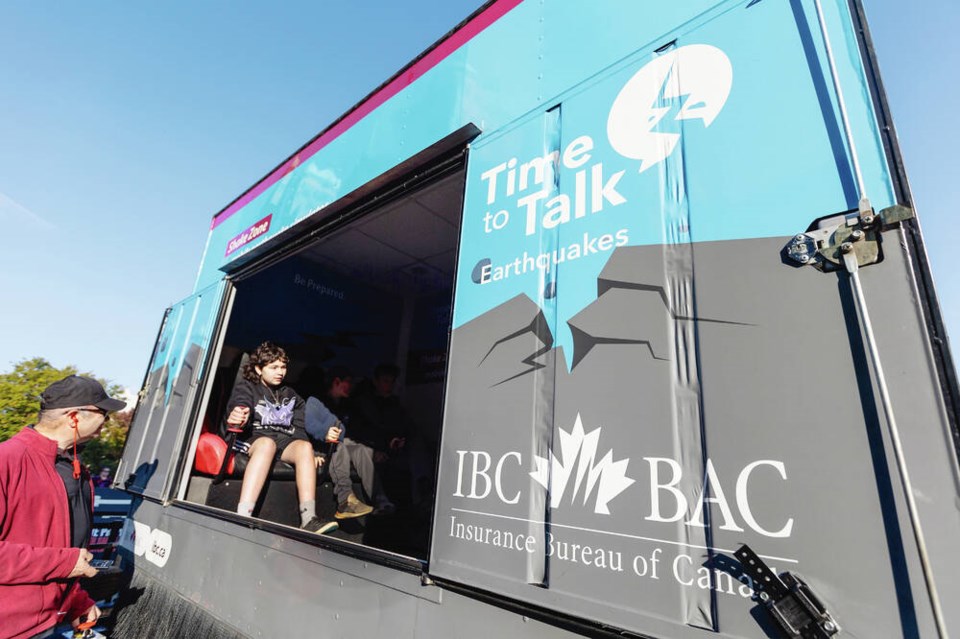An earthquake off Vancouver Island on Sunday — just as the province is set to mark the annual Great B.C. ShakeOut on Thursday — is a good reminder of the need to be prepared, says a Victoria seismologist.
The 4.9-magnitude quake happened Sunday night beneath the ocean about 200 kilometres west of Port Hardy, far enough from populated areas that there were no reports of it being noticed.
“Every day there are tiny earthquakes that aren’t felt, and even magnitudes 4 and 5 we see every month offshore,” said Natural Resources Canada seismologist John Cassidy.
He said the ShakeOut, a province-wide earthquake-readiness event, is a valuable exercise for the public. He also touted an earthquake early-warning system being developed by the federal government.
Warnings would come via existing public-alert structures such as cellphones, Cassidy said.
“It just gives you that audible warning to get under a table and hold on, just like we do during the ShakeOut drills — getting away from something that might fall onto you or windows that might break or a chimney that might come down,” he said, adding that for the really big offshore earthquakes, there might be a couple of minutes’ warning.
“Of course if you’re really close, if the earthquake is directly beneath you or within a few kilometres, there will be no warning time.”
The warning system can use automated sensors to stop elevators, alert doctors to halt surgery or prompt fire station doors to open before they’re damaged, Cassidy said.
It’s all part of an extended network to be managed by municipalities and regional districts, said City of Victoria emergency-program co-ordinator Tanya Seal-Jones.
With the help of grants from Natural Resources Canada, she said, 11 sensor stations will be installed in key locations around the Capital Regional District, like the main Victoria and Saanich fire halls.
Seismologist Taimi Mulder said the system could be up and running by the spring. It will have two data centres, one near Ottawa and one to be determined.
Mulder said the warning system won’t pick up on every event, just those of a predetermined magnitude.
“You want to know about the important ones,” she said. “There’s always a trade-off between false alerts and accuracy.”
The West Coast is “in the time window” for a major earthquake as high as a magnitude of 9, which happen about every 250 to 800 years, said Mulder, who noted the last one happened in 1700.
The Island and Puget Sound area, meanwhile, hasn’t seen a magnitude 6 or 7 quake since 1946 near Courtenay, she said.
Seal-Jones said the entire municipal staff — over 1,000 people — will be taking part in the ShakeOut, ducking and covering beneath tables and desks.
And since the activity starts at 10:19 a.m. across B.C. (the time denotes the month and day), council’s committee of the whole meeting starting at 9 a.m. will be paused as Seal-Jones leads councillors and others through their paces.
Another drill will be held at the main Victoria fire hall and a Teams session will be held for the rest of the staff.
In the Sooke School District, earthquake drills are being held to help reduce anxiety and confusion should an emergency come up.
“Like all drills, it offers an opportunity to prepare students and staff with the knowledge and steps to quickly react in the event of an emergency situation,” the district said in a statement. “We hope after participating in the drill, students will bring that knowledge home and spark conversations with their family and friends about earthquake preparedness, and how they would respond to an earthquake at home or in the community.”
ShakeOut drills can be short or part of a longer exercise. Many participants also use the day to review preparedness procedures and take stock of emergency supplies.
Along with schools, municipalities and businesses, seismologists and other staff at Natural Resources Canada's local headquarters on West Saanich Road are planning a ShakeOut drill.
Setting a good example is a positive thing, said Mulder.
“We’ll all hide under our desks and cover our heads and hold on,” she said. “And when that’s done we’ll be mustering outside and debriefing about what worked and didn’t work, and see if there are things we can do to go forward.”
B.C. had 700,000 participants in the ShakeOut drill in 2022.
The ShakeOut drill is on Thursday at 10:19 a.m. Register at shakeoutbc.ca.
If you’re indoors during an earthquake, drop to the ground, seek cover (such as under a desk), hold on until the shaking stops.
If you’re outdoors, find a clear spot, drop, cover and hold on. If you’re driving, pull over at a clear location, and stay in your vehicle with your seatbelt on.
>>> To comment on this article, write a letter to the editor: [email protected]



